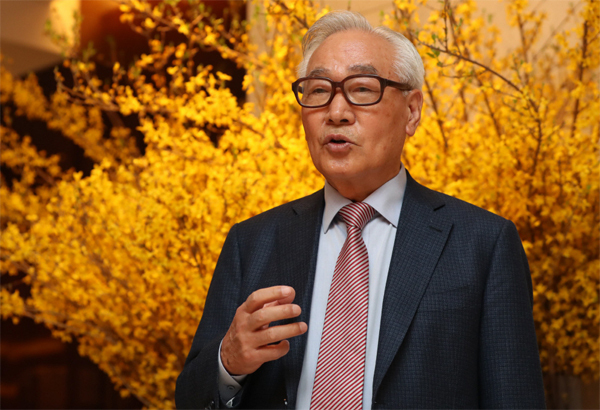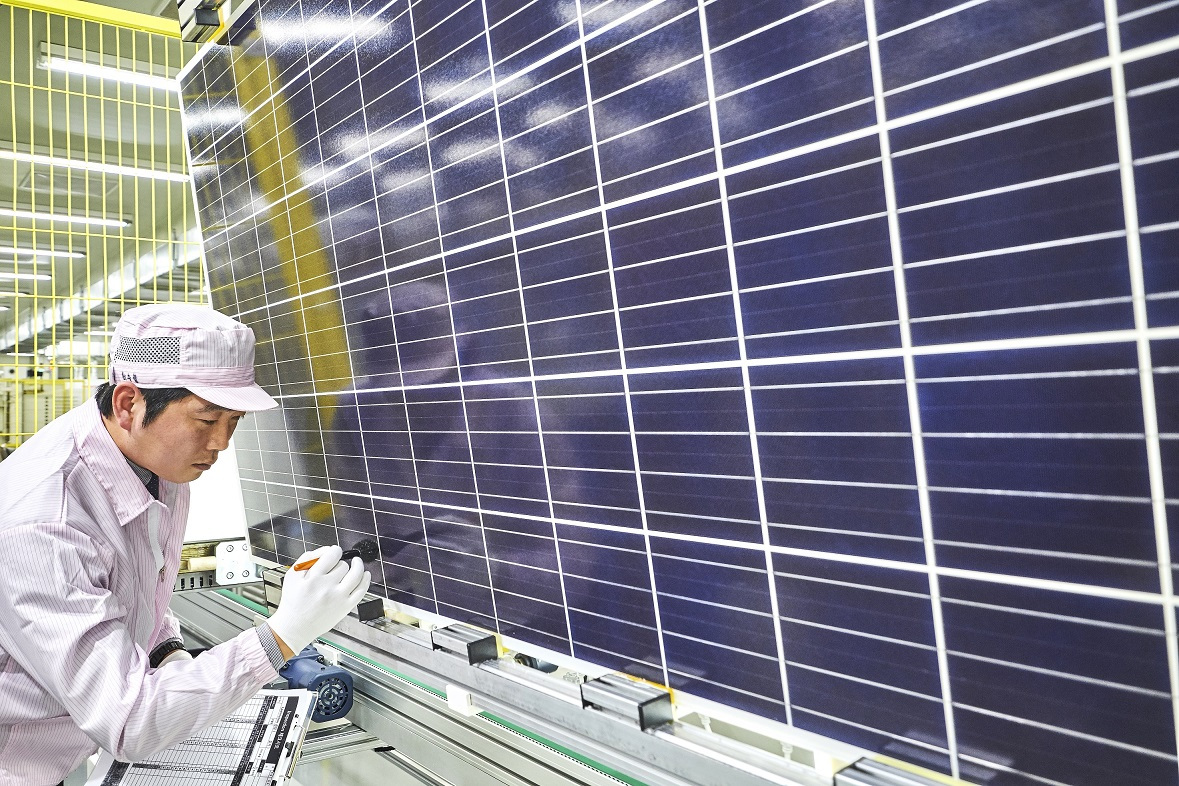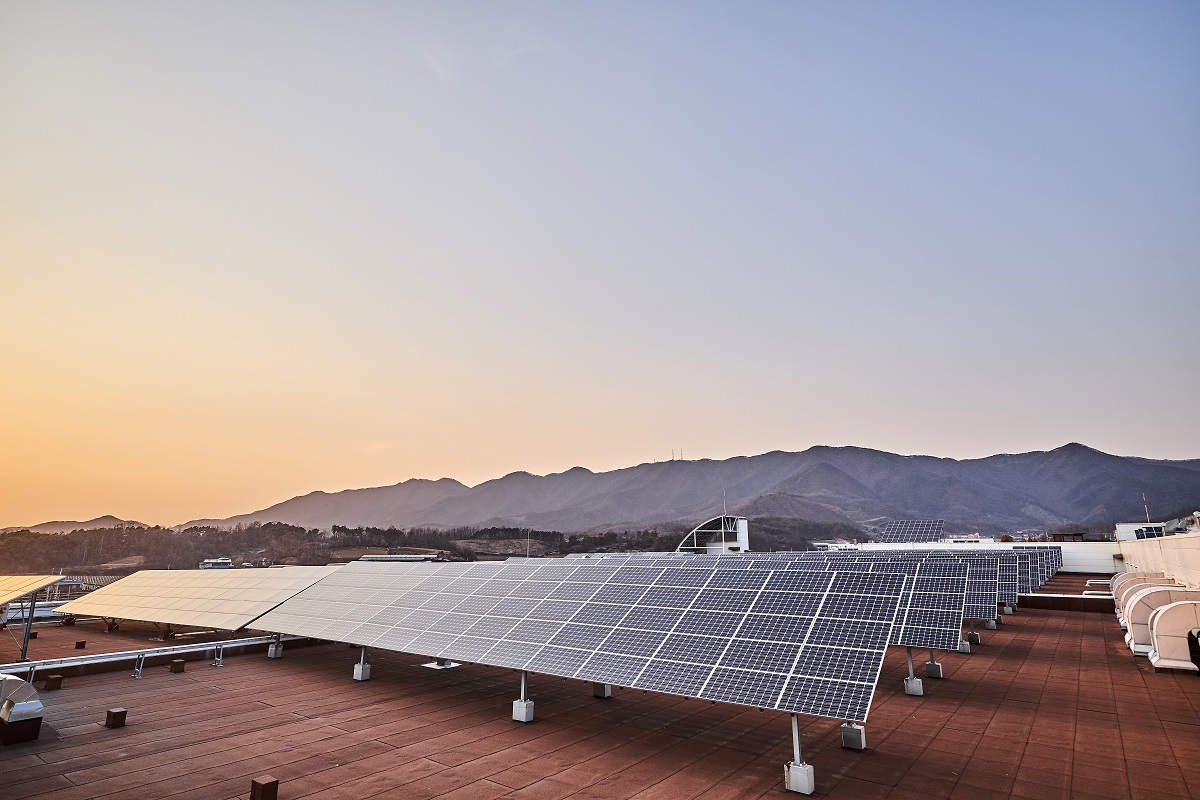
Shinsung E&G Chairman Lee Wan-keun (Shinsung E&G)
One year after Shinsung E&G launched a solar power business, the 2008 global financial crisis came, forcing the government to shut down subsidy programs for the industry. In 2010, a tsunami of cheap Chinese products flooded the market, leaving the Korean companies to shelve their solar power business.
Despite the aggravating market conditions, Shinsung E&G Chairman Lee Wan-keun stood firm, increasing investments to develop solar cell and module technologies and expanding production capacity.
The reason the chairman could hold his ground was simple -- it wasn’t his first rodeo.
“After starting business in 1977, Shinsung E&G had gone through major risks before it turned profits in new fields such as semiconductor cleanroom business and assembly automation equipment business,” said the 79-year-old chairman.
“Shinsung E&G solar power business was just getting started.”
Man of opportunity In 1977, Shinsung started as a refrigeration and air conditioning company. Several years later, the opportunity of a lifetime came knocking.
In the 1980s, Samsung Electronics jumped into the chips business. To manufacture semiconductors, it needed cleanrooms with air conditioning systems that could filter pollutants and supply clean air from outside.
At this moment, Samsung placed an order with Shinsung to supply equipment for cleanrooms as part of localization efforts. But there was a major hiccup -- Shinsung was given only one year to develop the equipment.
Shinsung first tried to affiliate with foreign companies and share their technology, but couldn’t find any partners. Several months passed without a clear answer, but one day, Chairman Lee woke up with an unorthodox idea: the Trojan horse.
When employees of Samsung Electronics went to Japan to buy equipment, Lee sent his people with them. After visiting factories in Japan, Shinsung employees could gather information in the field and fill information gaps.
With the hard-earned information from Japan, Shinsung managed to develop and supply the equipment to Samsung before the deadline.
Supplying cleanroom equipment for Samsung Electronics’ chip business and LG Electronics’ display business, Shinsung grew in size.
New challenge
After 30 years of plain sailing, Chairman Lee made a surprise announcement in 2007 to launch a solar power business.
“Shinsung needed a new challenge after years of doing semiconductor and display businesses. When looking for a new challenge, I learned about a solar power business. After getting consulting with industry officials and reading reports about the industry every night, I could make up my mind and announced the launch of solar power business,” the chairman said.
“However, when we actually started the business, it was more difficult than expected, so we went through a lot.”

Shinsung E&G inspects the company’s solar module. (Shinsung E&G)
One year after the launch, Shinsung’s solar power business took a hit from the 2008 global financial crisis, which clipped the growth of the global solar power industry. Then in 2010, the situation further deteriorated as Chinese companies started to enter the market and introduced cheap products based on state subsidies, causing oversupply issues.
“At the time, we could easily make profits as long as we could secure raw materials. We couldn’t possibly predict that the market would suffer oversupply issues and price competition would intensify,” the chairman said.
Starting from 2011, Shinsung hemorrhaged tens of millions of dollars in the solar power business and had to make up the losses in the cleanroom business.
Still, Shinsung decided to hold on to the solar power business, and its long wait is finally paying off thanks to President Moon Jae-in’s aggressive push for renewable energy.
Bouncing backIn a decade, a turnaround finally came to Shinsung’s money-losing renewable energy business.
After taking office in 2017, President Moon pledged to roll out 27.9 gigawatts of solar and wind power by 2025.
In July, Moon doubled down on his commitment when he announced his Green New Deal initiative -- a massive job creation program via the promotion of renewable energy -- recalibrating the target to 42.7 gigawatts.
To reach the ambitious target, the government has been offering generous subsidies for those who generate electricity with solar or wind power. The subsidies naturally led to higher demand for solar modules, including those manufactured by Shinsung.

Shinsung E&G’s rooftop solar farm (Shinsung E&G)
To meet growing demand in the solar power market amid the Green New Deal, the company in June decided to construct a new solar module plant in Gimje, North Jeolla Province, with an annual capacity of 600 megawatts to produce 450-kilowatt solar modules.
In July, Shinsung signed a contract with construction company Hanyang to supply solar modules for the country’s biggest floating solar farm with a capacity of 73 megawatts.
For a 96-megawatt solar farm underway in Shinan, South Jeolla Province, Shinsung has provided solar modules since July and will continue to do so until next month.
In August, Shinsung signed a contract with Hyosung Heavy Industries to supply solar modules totaling 24 megawatts for a solar farm project in Shinan.
“Thanks to winning big contracts, Shinsung expects its performance to improve in the second half of this year,” a company official said.
In the fourth quarter last year, Shinsung’s renewable energy business recorded revenue of 44.5 billion won ($38 million), but suffered an operating loss of 467 million won.
In the first quarter this year, revenue fell to 38.6 billion won but operating profit improved to 419 million won. In the second quarter, revenue declined to 26.2 billion won, but operating profit spiked to 3 billion won.
China risk
Despite improving operating profits, Shinsung still faces stiff competition in Chinese solar power companies.
“The Chinese government doesn’t impose taxes when establishing solar power companies or investing in them. It even offers public funds for research. For domestic companies to gain confidence in the competition and to raise its production capacity, government support is pivotal,” the chairman said.
Last year, Chinese companies dominated the value chain of the global solar power industry, commanding 64 percent, 92 percent, 85 percent and 80 percent in the polysilicon, wafer, cell and module markets, respectively.
However, the chairman said that there is still a chance for Korean companies to stay competitive.
“Since 2018, demand started to rise for products with high quality and efficiency. Korean companies are ready to manufacture high-end products,” he said.
“Polysilicon is the raw material that makes up solar power products. When this raw material is processed to make solar cells, the technology correlates with semiconductor technology. This is why Korean companies with know-how in the semiconductors business have a competitive edge in their solar power products.”
By Kim Byung-wook (kbw@heraldcorp.com)








